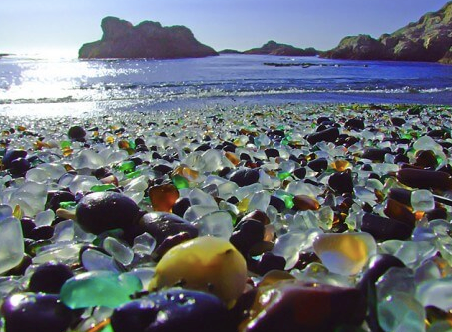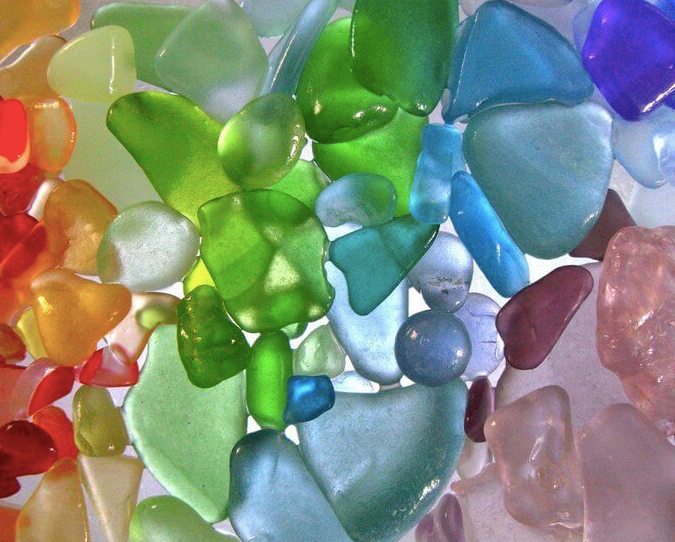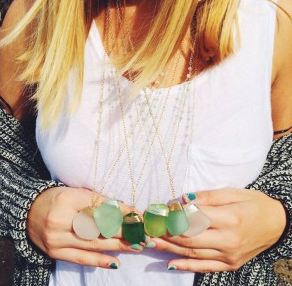Seaglass Explained
So what is Seaglass you ask?
Seaglass can be found along beaches or bodies of salt water throughout the world. These amazing little ocean made gems originate from glass bottles or objects that have washed into the ocean or gone down in ship wrecks. The ocean naturally breaks them down into shards and tumbles them around continuously for decades until it has created a smooth, rounded, frosty stone that eventually washes ashore. The distinctive features of Seaglass take between 20-30 years to create with some Seaglass being up to 50-150 years old.
Where can you find it?
Seaglass can be found internationally however the best known hotspots for collectors are California, Mexico, Hawaii, Puerto Rico, Nova Scotia, Australia, Italy and Southern Spain but if you want to get really serious you need to head to Bermuda where there are some of the most incredible Seaglass blanketed beaches in the world!

Colour
The colour of Seaglass is dependent upon its origin. Most of the glass begins its life as beer or soft drink bottles so brown, clear and green are common however some of the glass comes from jars, plates, windows or windscreens so other colours exist but are far rarer.
Rare colours include Jade, Amber, Lime Green, Forest Green and Ice or Soft Blue. These pieces originate from whiskey, medicine, spirit bottles and even early bleach bottles
Very rare colours include a particular type of green that came from Coca-Cola and Dr Pepper bottles from the 1950’s and soft green colours which are produced from ink bottles, fruit jars and baking soda bottles from the late 19th and early 20th century.
Other rare colours include purple, citron, opaque white (from milk bottles) cobalt, cornflower blue (from poison bottles, artwork, bromo seltzer and Vicks VapoRub) aqua (from the original Mason Jars and 19th Century bottles) grey, pink (often from plates of the Great Depression) teal (Mateus Wine Bottles) black, yellow (1930s Vaseline) turquoise (from tableware and artglass) red (often from tail lights and dinnerware)
The rarest of them all is black glass which was thick and commonly used for wine, gin, whiskey, medicines and liquids prone to light damage. These were traditionally refilled once emptied and reused for decades until they eventually broke. Many examples of black glass date back to the 15th century and can be found in slave trading ports and all former colonial locations with sea trade routes and motherland shipping ports.
Black glass is generally a dark green or brown when held up to light but often appears black the majority of the time. Due to its similarity to the black beach rock basalt the best way to determine whether a piece is Seaglass or Rock is to look for gas bubbles, impurities and irregularities, these are usually clear indicators of black glass from this time.

In many locations it can be considered theft to remove items such as Black Sea Glass due to its historical nature. In other locations it goes unnoticed and is simply considered trash.
Some beaches have been known to be made national treasures due to the amount of glass blanketing the shore. Glass beach at Fort Bragg California is a good example.
Beach Glass
Glass from inland waterways is known as beach glass, it holds similarities to Seaglass but the lack of vigourous movement or waves and the lower salt content means they are typically less weathered than Seaglass. They are often inconsistent in their texture which is usually caused by pieces breaking off larger glass objects that are embedded in clay, silt or mud. Once broken off only part of the shard has been weathered so one side could be frosted and the other side shiny.
Artificial Sea Glass
Artificial versions are now being produced and often passed off as genuine Seaglass as it becomes increasingly rare. Artificial seaglass is similar in appearance but the glass is not from the sea, instead the shards are put in a rock tumbler or dipped in acid to get a desired finish so essentially they are manufactured as a new product and have no history.

Sea Pottery
Sea Pottery is the sister to Seaglass and originates from crockery, vases and other ceramic, porcelain or clay pieces that have been naturally weathered by the acidity and motion of the sea or a body of water. Most Sea Pottery originates from 18th & 19th Century Porcelain and can be identified and dated by the markings, patterns and colours on the pieces.
Due to the popularity of Seaglass and Sea Pottery, collectors have taken a great deal of it from beaches where it was commonly found making it increasingly rare to find.
We believe the beauty of genuine Seaglass comes with its years of battling waves and tides, each colourful piece has a history and a story to tell.
Upcycle Studio has released a unique collection of beautiful accessories from Laguna Beach California using genuine Seaglass. Shop our Sea Candy collection here


